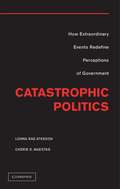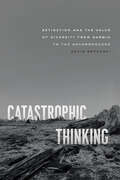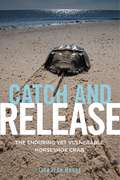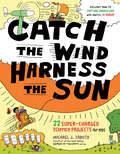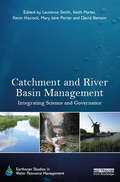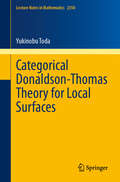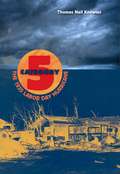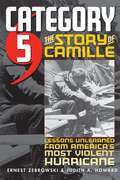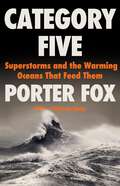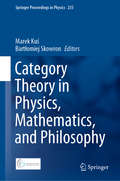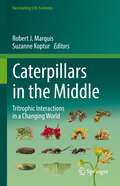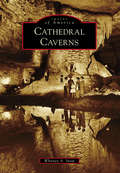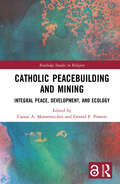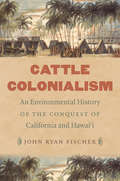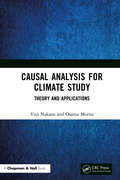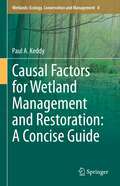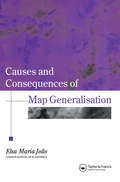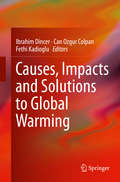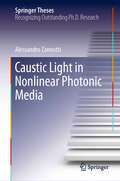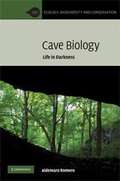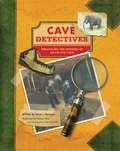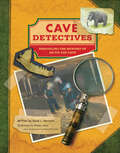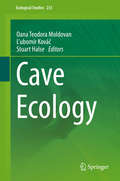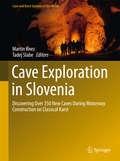- Table View
- List View
Catastrophic Politics
by Lonna Rae Atkeson Cherie D. Maestas"Shocking moments in society create an extraordinary political environment that permits political and opinion changes that are unlikely during times of normal politics. Strong emotions felt by the public during catastrophes, even if experienced only vicariously through media coverage are a powerful motivator of public opinion and activism. This is particularly true when emotional reactions coincide with attributing blame to governmental agencies or officials. By examining public opinion during one extraordinary event, the aftermath of Hurricane Katrina, Lonna Rae Atkeson and Cherie D. Maestas show how media information interacts with emotion in shaping a wide range of political opinions about government and political leaders. Catastrophic events bring citizens together, provide common experiences and information, and create opinions that transcend traditional political boundaries. These moments encourage citizens to reexamine their understanding of government, its leaders, and its role in a society from a less partisan perspective"--
Catastrophic Thinking: Extinction and the Value of Diversity from Darwin to the Anthropocene (science.culture)
by David SepkoskiA history of scientific ideas about extinction that explains why we learned to value diversity as a precious resource at the same time as we learned to “think catastrophically” about extinction. We live in an age in which we are repeatedly reminded—by scientists, by the media, by popular culture—of the looming threat of mass extinction. We’re told that human activity is currently producing a sixth mass extinction, perhaps of even greater magnitude than the five previous geological catastrophes that drastically altered life on Earth. Indeed, there is a very real concern that the human species may itself be poised to go the way of the dinosaurs, victims of the most recent mass extinction some 65 million years ago. How we interpret the causes and consequences of extinction and their ensuing moral imperatives is deeply embedded in the cultural values of any given historical moment. And, as David Sepkoski reveals, the history of scientific ideas about extinction over the past two hundred years—as both a past and a current process—is implicated in major changes in the way Western society has approached biological and cultural diversity. It seems self-evident to most of us that diverse ecosystems and societies are intrinsically valuable, but the current fascination with diversity is a relatively recent phenomenon. In fact, the way we value diversity depends crucially on our sense that it is precarious—that it is something actively threatened, and that its loss could have profound consequences. In Catastrophic Thinking, Sepkoski uncovers how and why we learned to value diversity as a precious resource at the same time as we learned to think catastrophically about extinction.
Catch and Release: The Enduring Yet Vulnerable Horseshoe Crab
by Lisa Jean MooreThe unexpected and fascinating interspecies relationship between humans and horseshoe crabs.Horseshoe crabs are considered both a prehistoric and indicator species. They have not changed in tens of millions of years and provide useful data to scientists who monitor the health of the environment. From the pharmaceutical industry to paleontologists to the fishing industry, the horseshoe crab has made vast, but largely unknown, contributions to human life and our shared ecosystem. Catch and Release examines how these intersections steer the trajectory of both species’ lives, and futures. Based on interviews with conservationists, field biologists, ecologists, and paleontologists over three years of fieldwork on urban beaches, noted ethnographer Lisa Jean Moore shows how humans literally harvest the life out of the horseshoe crabs. We use them as markers for understanding geologic time, collect them for agricultural fertilizer, and eat them as delicacies, capture them as bait, then rescue them for conservation, and categorize them as endangered. The book details the biomedical bleeding of crabs; how they are caught, drained of 40% of their blood, and then released back into their habitat. The model of catch and release is essential. Horseshoe crabs cannot be bred in captivity and can only survive in their own ecosystems. Moore shows how horseshoe crabs are used as an exploitable resource, and are now considered a “vulnerable” species.An investigation of how humans approach animals that are essential for their survival, Catch and Release questions whether humans should have divine, moral, or ethical claims to any living being in their path.
Catch the Wind, Harness the Sun: 22 Super-Charged Projects for Kids
by Michael J. CadutoGet charged up about energy! With more than 20 fun activities and experiments that will have children ages 8 to 12 enthusiastically engaged with making and using renewable energy, Michael J. Caduto takes a hands-on approach to fighting climate change. Step-by-step instructions for projects range from using the sun to make fires to charging electronic devices by peddling your bicycle. Additional energy case studies encourage kids to think about the basic tenets of resource management. Change the world — one miniature windmill at a time.
Catching Fog // Making Rain (Fountas & Pinnell LLI Purple #Level S)
by Sarah BrockettProvides information about increasing water supply.
Catchment and River Basin Management: Integrating Science and Governance (Earthscan Studies in Water Resource Management)
by Kevin Hiscock David Benson Keith Porter Laurence Smith Mary Jane PorterThe central focus of this volume is a critical comparative analysis of the key drivers for water resource management and the provision of clean water – governance systems and institutional and legal arrangements. The authors present a systematic analysis of case study river systems drawn from Australia, Denmark, Germany, the Netherlands, UK and USA to provide an integrated global assessment of the scale and key features of catchment management. A key premise explored is that despite the diversity of jurisdictions and catchments there are commonalities to a successful approach. The authors show that environmental and public health water quality criteria must be integrated with the economic and social goals of those affected, necessitating a 'twin-track' and holistic (cross-sector and discipline) approach of stakeholder engagement and sound scientific research. A final synthesis presents a set of principles for adaptive catchment management. These principles demonstrate how to integrate the best scientific and technical knowledge with policy, governance and legal provisions. It is shown how decision-making and implementation at the appropriate geographic and governmental scales can resolve conflicts and share best sustainable practices.
Categorical Donaldson-Thomas Theory for Local Surfaces (Lecture Notes in Mathematics #2350)
by Yukinobu TodaThis book provides an introduction to categorical Donaldson-Thomas (DT) theory, a rapidly developing field which has close links to enumerative geometry, birational geometry, geometric representation theory and classical moduli problems in algebraic geometry. The focus is on local surfaces, i.e. the total spaces of canonical line bundles on algebraic surfaces, which form an interesting class of Calabi-Yau 3-folds. Using Koszul duality equivalences and singular support theory, dg-categories are constructed which categorify Donaldson-Thomas invariants on local surfaces. The DT invariants virtually count stable coherent sheaves on Calabi-Yau 3-folds, and play an important role in modern enumerative geometry, representation theory and mathematical physics. Requiring a basic knowledge of algebraic geometry and homological algebra, this monograph is primarily addressed to researchers working in enumerative geometry, especially Donaldson-Thomas theory, derived categories of coherent sheaves, and related areas.
Category 5: The 1935 Labor Day Hurricane
by Thomas Neil KnowlesIn the midst of the Great Depression, a furious storm struck the Florida Keys with devastating force. With winds estimated at over 225 miles per hour, it was the first recorded Category 5 hurricane to make landfall in the United States.Striking at a time before storms were named, the catastrophic tropical cyclone became known as the 1935 Labor Day Hurricane, and its aftermath was felt all the way to Washington, D.C. In the hardest hit area of the Florida Keys, three out of every five residents were killed, while hundreds of World War I veterans sent there by the federal government perished.By sifting through overlooked official records and interviewing survivors and the relatives of victims, Thomas Knowles pieces together this dramatic story, moment by horrifying moment. He explains what daily life was like on the Keys, why the veteran work force was there (and relatively unprotected), the state of weather forecasting at the time, the activities of the media covering the disaster, and the actions of government agencies in the face of severe criticism over their response to the disaster.The Labor Day Hurricane of 1935 remains one of the most intense to strike America's shores. Category 5 is a sobering reminder that even with modern meteorological tools and emergency management systems, a similar storm could cause even more death and destruction today.
Category 5: The Story of Camille, Lessons Unlearned from America's Most Violent Hurricane
by Ernest Zebrowski Judith A. HowardCamille’s nearly 200 mile per hour winds and 28-foot storm surge swept away thousands of homes and businesses along the Gulf Coast of Louisiana and Mississippi. Twenty-four oceangoing ships sank or were beached; six offshore drilling platforms collapsed; 198 people drowned. Two days later, Camille dropped 108 billion tons of moisture drawn from the Gulf onto the rural communities of Nelson County, Virginia—nearly three feet of rain in 24 hours. Mountainsides were washed away; quiet brooks became raging torrents; homes and whole communities were simply washed off the face of the earth. In this gripping account, Ernest Zebrowski and Judith Howard tell the heroic story of America’s forgotten rural underclass coping with immense adversity and inconceivable tragedy. Category 5 shows, through the riveting stories of Camille’s victims and survivors, the disproportionate impact of natural disasters on the nation’s poorest communities. It is, ultimately, a story of the lessons learned—and, in some cases, tragically unlearned—from that storm: hard lessons that were driven home once again in the awful wake of Hurricane Katrina.
Category Five: Superstorms and the Warming Oceans That Feed Them
by Porter FoxSuperstorms, hurricanes, typhoons, and spiraling freak weather: the fallout of global warming is a real-life natural thriller, as captured in Porter Fox&’s urgent and stunning story of chasing the world&’s most devastating storms. Here is the story of the largest storms on earth and how those storms are growing bigger and stronger. The tale of extreme weather doesn&’t begin with floods, fires, or even the air that carries this change to our lives. It begins with the ocean. Oceans create weather, climate, floods, droughts, and most of the geophysical fallout of global warming. Exactly how, award-winning writer Porter Fox contends, depends on invisible ocean currents, planetary cycles just now being defined, and processes in the deep ocean that may well have already saved us from the worst effects of the climate crisis. In an attempt to avert a coming age of superstorms, sea level rise, and catastrophic warming, scientists followed the lead of a college drop-out-turned-maverick sailor and storm-chaser; a Romanian refugee turned BBC radio host turned circumnavigating mapmaker; and an audacious new attempt to study storms above as well as deep below the ocean depths, using drones. Throughout Category Five, Fox shadows these explorers, scientists, oceanographers, and weather forecasters in an attempt to understand, forestall, and possibly harness the awesome power of our oceans.
Category Theory in Physics, Mathematics, and Philosophy (Springer Proceedings in Physics #235)
by Marek Kuś Bartłomiej SkowronThe contributions gathered here demonstrate how categorical ontology can provide a basis for linking three important basic sciences: mathematics, physics, and philosophy. Category theory is a new formal ontology that shifts the main focus from objects to processes.The book approaches formal ontology in the original sense put forward by the philosopher Edmund Husserl, namely as a science that deals with entities that can be exemplified in all spheres and domains of reality. It is a dynamic, processual, and non-substantial ontology in which all entities can be treated as transformations, and in which objects are merely the sources and aims of these transformations.Thus, in a rather surprising way, when employed as a formal ontology, category theory can unite seemingly disparate disciplines in contemporary science and the humanities, such as physics, mathematics and philosophy, but also computer and complex systems science.
Caterpillars in the Middle: Tritrophic Interactions in a Changing World (Fascinating Life Sciences)
by Robert J. Marquis Suzanne KopturCaterpillars are excellent model organisms for understanding how multiple selective forces shape the ecology and evolution of insects, and organisms in general. Recent research using the tools of modern molecular biology, genetics, metabolomics, microbial ecology, experiments conducted at a global level, network analysis, and statistical analyses of global data sets, combined with basic natural history, are yielding exciting new insights into caterpillar adaptations and ecology. The best way to view these research advances is within a framework of tri-trophic interactions. This is a timely topic for research given the central role of caterpillars and plants in the ecology and trophic structure of terrestrial communities. This book is unique in that it contains chapters from a team of experts on a diversity of key topics within caterpillar-plant interactions. This volume brings together contributions by researchers from around the globe, working in both tropical and temperate habitats, and in human-managed and more natural habitats. It is a significant contribution to our understanding of insect biology, and the role that insects, as represented by caterpillars, play in a world increasingly dominated by humans and one in which threats to insect biodiversity are mounting.Chapter 11 is available open access under a Creative Commons Attribution 4.0 International License via link.springer.com.
Cathedral Caverns (Images of America)
by Whitney A. SnowIn 1952, Jacob “Jay” Gurley explored a Marshall County, Alabama, curiosity known as Bat Cave. Amazed by its stalagmites and sheer enormity, he purchased the site and began transforming it into Cathedral Caverns, a spectacular tourist attraction that eventually became a national natural landmark in 1973 and a state park in 2000. Had it not been for Gurley’s hard work and dedication, this cave, a geological treasure of international renown, might have remained a little-known hole in the ground. His efforts impacted local and state tourism, economics, and politics. This is the story of one man and his vision.
Catholic Peacebuilding and Mining: Integral Peace, Development, and Ecology (Routledge Studies in Religion)
by Caesar A. MontevecchioThis book explores the role of Catholic peacebuilding in addressing the global mining industry. Mining is intimately linked to issues of conflict, human rights, sustainable development, governance, and environmental justice. As an institution of significant scope and scale with a large network of actors at all levels and substantial theoretical and ethical resources, the Catholic Church is well positioned to acknowledge the essential role of mining, while challenging unethical and harmful practices, and promoting integral peace, development, and ecology. Drawing together theology, ethics, and praxis, the volume reflects the diversity of Catholic action on mining and the importance of an integrated approach. It includes contributions by an international and interdisciplinary range of scholars and practitioners. They examine Catholic action on mining in El Salvador, Peru, Colombia, the Democratic Republic of the Congo, and the Philippines. They also address general issues of corporate social responsibility, human rights, development, ecology, and peacebuilding. The book will be of interest to scholars of theology, social ethics, and Catholic studies as well as those specializing in development, ecology, human rights, and peace studies.
Cattle Colonialism: An Environmental History of the Conquest of California and Hawai'i (Flows, Migrations, and Exchanges)
by John Ryan FischerIn the nineteenth century, the colonial territories of California and Hawai'i underwent important cultural, economic, and ecological transformations influenced by an unlikely factor: cows. The creation of native cattle cultures, represented by the Indian vaquero and the Hawaiian paniolo, demonstrates that California Indians and native Hawaiians adapted in ways that allowed them to harvest the opportunities for wealth that these unfamiliar biological resources presented. But the imposition of new property laws limited these indigenous responses, and Pacific cattle frontiers ultimately became the driving force behind Euro-American political and commercial domination, under which native residents lost land and sovereignty and faced demographic collapse.Environmental historians have too often overlooked California and Hawai'i, despite the roles the regions played in the colonial ranching frontiers of the Pacific World. In Cattle Colonialism, John Ryan Fischer significantly enlarges the scope of the American West by examining the trans-Pacific transformations these animals wrought on local landscapes and native economies.
Causal Analysis for Climate Study: Theory and Applications
by Osamu Morita Yuji NakanoThis book offers the theory of causal analysis and its applications. The authors have developed this book in relation to its applications to four climatological phenomena to prove the theory of causal analysis in time sequential data analysis.Local Causal Test and the Partial Causal Test are used to study the theory of causal analysis. These are then applied to understand the climate effects of the eruption at Mt. Pinatubo, the effect of the El Niño and Southern Oscillation (ENSO), and the North Atlantic Oscillation (NAO). The reader learns about Test(S), a statistical test used to determine if the statistical properties of the data, such as mean and variance, remain constant over time within a local window. The authors also use the Stationary Test and Causality Test in time series to explore relationships within a localized subset of data as witnessed from the climate phenomenon. The book looks at the eruption at Mt. Pinatubo, ENSO, and NAO and applies causal theory to study the resultant air temperature at the 1000 hPa pressure level, geopotential height of 1000 hPa pressure surface, and surface precipitation. The program code of the causal analysis is offered for readers to be able to reconfirm the results and apply it to other time-sequential data.This book is useful for researchers and graduate students of applied mathematics, physics, geophysics, meteorology, oceanography, engineering technology, and economics.
Causal Factors for Wetland Management and Restoration: A Concise Guide (Wetlands: Ecology, Conservation and Management #8)
by Paul A. KeddyThis book presents 12 effective methods to manage wetlands for conservation. It offers a tool box of causal factors that can be used to protect and restore wetlands to enhance biological diversity and other functions. Each causal factor is introduced, briefly explained, and then illuminated with selected examples from around the world.The book provides a prioritized shopping list of methods for protecting and restoring wetlands. The three first and most important causal factors are flooding, fertility, and natural disturbance. Then nine other causal factors are introduced, including herbivory, sedimentation, roads, invasive species, and coarse woody debris. Each causal factor is carefully linked to the scientific literature and explained using the author’s own experience. The same list of 12 causal factors applies around the world—whether you are managing a temperate zone floodplain, a tropical peatland, a freshwater marsh, or a coastal mangrove swamp. Instead of hiring an expensive team of consultants, or pouring through hundreds of scientific papers, here is one concise guide to methods that can be immediately applied to benefit any wetland.Professor Paul Keddy has spent more than 50 years studying wetlands, and writing and lecturing about the environmental factors that control them. He has published more than 150 scholarly papers, and won multiple scientific prizes. His book Wetland Ecology is widely used to teach the principles of wetland science. Causal Factors for Wetland Management: A Concise Guide has a much simpler message: how to protect and enhance wetlands. In this concise guide, he has condensed a lifetime of experience into just 12 principles. The book is aimed at all people who protect or restore wetlands: park managers, wildlife biologists, landscape architects, engineers, environmental consultants, environmental agencies, conservation authorities, and NGOs—as well as landowners and concerned citizens. Causal Factors for Wetland Management: A Concise Guide is essential reading for anyone who cares for wetlands and wild places.
Causes And Consequences Of Map Generalization
by Elsa JoaoThis text describes late-1990s understanding of map generalisation in the context of paper maps and GIS. Its particular value should be in helping to further automate and measure the process of map generalisation.; The research has concentrated on quantifying generalisation effects and on analysing how these effects of generalisation locked into the maps were measured. Elsa Joao's book covers the background to the problems of map generlasation; the methodology developed by the author to investigate the consequences of the map generalisation; a detailed description of results, and a conclusion that draws together consequences for the broader applications to GIS.
Causes, Impacts and Solutions to Global Warming
by Ibrahim Dincer Can Ozgur Colpan Fethi KadiogluGlobal Warming: Causes, Impacts and Solutions covers all aspects of global warming including its causes, impacts, and engineering solutions. Energy and environment policies and strategies are scientifically discussed to expose the best ways to reduce global warming effects and protect the environment and energy sources affected by human activities. The importance of green energy consumption on the reduction of global warming, energy saving and energy security are also discussed. This book also focuses on energy management and conservation strategies for better utilization of energy sources and technologies in buildings and industry as well as ways of improving energy efficiency at the end use, and introduces basic methods for designing and sizing cost-effective systems and determining whether it is economically efficient to invest in specific energy efficiency or renewable energy projects, and describes energy audit producers commonly used to improve the energy efficiency of residential and commercial buildings as well as industrial facilities. These features and more provide the tools necessary to reduce global warming and to improve energy management leading to higher energy efficiencies. In order to reduce the negative effects of global warming due to excessive use of fossil fuel technologies, the following alternative technologies are introduced from the engineering perspective: fuel cells, solar power generation technologies, energy recovery technologies, hydrogen energy technologies, wind energy technologies, geothermal energy technologies, and biomass energy technologies. These technologies are presented in detail and modeling studies including case studies can also be found in this book.
Caustic Light in Nonlinear Photonic Media (Springer Theses)
by Alessandro ZannottiCaustics are natural phenomena, forming light patterns in rainbows or through drinking glasses, and creating light networks at the bottom of swimming pools. Only in recent years have scientists started to artificially create simple caustics with laser light. However, these realizations have already contributed to progress in advanced imaging, lithography, and micro-manipulation. In this book, Alessandro Zannotti pioneers caustics in many ways, establishing the field of artificial caustic optics. He employs caustic design to customize high-intensity laser light. This is of great relevance for laser-based machining, sensing, microscopy, and secure communication. The author also solves a long standing problem concerning the origin of rogue waves which appear naturally in the sea and can have disastrous consequences. By means of a far-reaching optical analogy, he identifies scattering of caustics in random media as the origin of rogue waves, and shows how nonlinear light-matter interaction increases their probability.
Cave Biology: Life in Darkness
by Aldemaro Romero Danté FenolioBiospeleology, the study of organisms that live in caves, has a tremendous potential to inform many aspects of modern biology; yet this area of knowledge remains largely anchored in neo-Lamarckian views of the natural world in both its approaches and jargon. Written for graduate students and academic researchers, this book provides a critical examination of current knowledge and ideas on cave biology, with emphasis on evolution, ecology, and conservation. Aldemaro Romero provides a historical analysis of ideas that have influenced biospeleology, discusses evolutionary phenomena in caves, from cave colonization to phenotypic and genotypic changes, and integrates concepts and knowledge from diverse biological viewpoints. He challenges the conventional wisdom regarding the biology of caves, and highlights urgent questions that should be addressed in order to get a better and more complete understanding of caves as ecosystems.
Cave Detectives: Unraveling the Mystery of an Ice Age Cave
by David L. HarrisonWhat was life like millions of years ago? The answer lies deep underground, in a place once home to a ferocious predator much larger than most animals walking around today. Through photographs and detailed illustrations, readers will learn how the secrets buried in a midwestern hillside helped scientists understand early life on Earth. This book's simple but informative format allows readers to follow along as paleontologist Matt Forir and his team of experts unravel a prehistoric mystery. Plus, this is the fixed-format version, which looks nearly identical to the print edition.
Cave Detectives: Unraveling the Mystery of an Ice Age Cave
by David L. Harrison&“Vivid descriptions of the animals, the cave, and the scientists are complemented by the original art and photos that work together unusually well.&” —Booklist What was life like millions of years ago? The answer lies deep underground, in a place once home to a ferocious predator much larger than most animals walking around today. Through photographs and detailed illustrations, readers will learn how the secrets buried in a midwestern hillside helped scientists understand early life on Earth. This book&’s simple but informative format allows readers to follow along as paleontologist Matt Forir and his team of experts unravel a prehistoric mystery. &“[An] account of the discovery and early exploration of Missouri&’s Riverbluff Cave, the oldest found so far in this country with fossil remains . . . may excite curiosity about the Riverbluff finds.&” —Kirkus Reviews
Cave Ecology (Ecological Studies #235)
by Oana Teodora Moldovan Ľubomír Kováč Stuart HalseCave organisms are the ‘monsters’ of the underground world and studying them invariably raises interesting questions about the ways evolution has equipped them to survive in permanent darkness and low-energy environments. Undertaking ecological studies in caves and other subterranean habitats is not only challenging because they are difficult to access, but also because the domain is so different from what we know from the surface, with no plants at the base of food chains and with a nearly constant microclimate year-round. The research presented here answers key questions such as how a constant environment can produce the enormous biodiversity seen below ground, what adaptations and peculiarities allow subterranean organisms to thrive, and how they are affected by the constraints of their environment. This book is divided into six main parts, which address: the habitats of cave animals; their complex diversity; the environmental factors that support that diversity; individual case studies of cave ecosystems; and of the conservation challenges they face; all of which culminate in proposals for future research directions. Given its breadth of coverage, it offers an essential reference guide for graduate students and established researchers alike.
Cave Exploration in Slovenia: Discovering Over 350 New Caves During Motorway Construction on Classical Karst (Cave and Karst Systems of the World)
by Martin Knez Tadej SlabeThis book focuses on the opening and exploration of more than 350 previously undiscovered caves of the Slovenian Karst, discovered during motorway construction work. The summarizes the planning of traffic roads and presents the new findings obtained during construction, as well as studies on newly-discovered karst phenomena and karst waters and their protection. Earthmoving work during construction has revealed a cross-section of the surface of the Classical Karst, covered karst with famous underground stone forests and unique karst in breccia. Research conducted in these caves has yielded a number of new findings on how the karst surface and underground were formed, on the flow of water through karst aquifers, and on the evolution of karst on various types of rock and under various conditions. The work was written by researchers from the ZRC SAZU Karst Research Institute and the Institute of Geology AS CR. The reader will benefit from the authors' collaboration with planners and builders, which offers valuable insights for the planning and execution of their own activities in karst regions.
